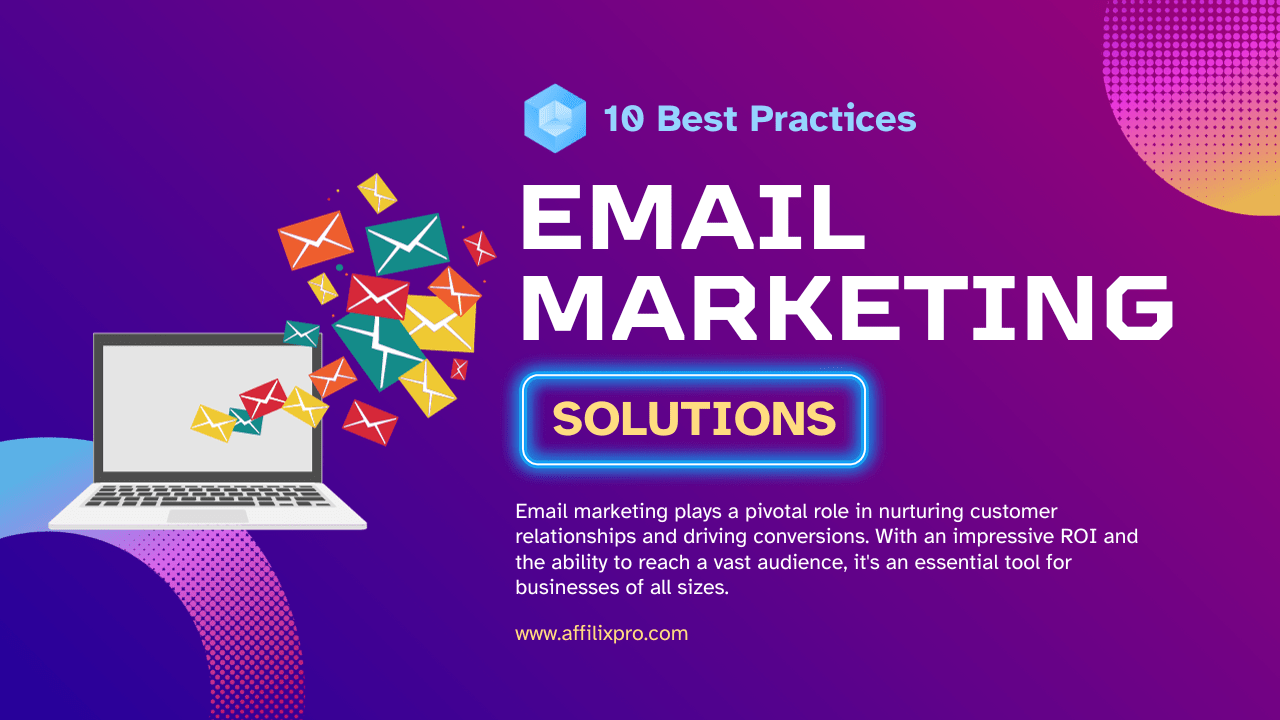8 Email Marketing Mastery for Growing Your Blog
Email marketing mastery stands as the linchpin in the dynamic world of blogging, offering a direct and personalized channel to connect with your audience. In this section, we’ll delve into why mastering email marketing is not just beneficial but absolutely crucial for the sustained growth of your blog.
1. Why Email Marketing Matters for Blogs
Unlocking a Wider Reach
Email marketing extends the reach of your blog content beyond the confines of your website. By landing directly in your subscribers’ inboxes, your messages have a higher chance of being noticed amidst the digital noise.
Fostering Deeper Audience Connection
Unlike social media, email allows for more intimate communication. Subscribers willingly share their email addresses, signifying a deeper level of interest in your content. Use this privileged access to build meaningful connections.
Driving Sustainable Growth
While social media algorithms can change overnight, your email list remains a constant asset. Building a robust subscriber base ensures a stable and engaged audience that can weather the unpredictable winds of online trends.
2. Getting Started: Setting Up Your Blog for Email Success
Choose the Right Email Marketing Platform
Select an email marketing platform that aligns with your blogging needs. Whether it’s Mailchimp, Constant Contact, or others, ensure it integrates seamlessly with your blog and offers the features you require.
Create Compelling Opt-In Incentives
Entice visitors to subscribe by offering valuable incentives such as exclusive content, downloadable resources, or special promotions. Craft opt-in incentives that resonate with your target audience.
Design a User-Friendly Opt-In Process
Simplify the subscription process to minimize friction. Optimize your opt-in forms for easy access and ensure they are strategically placed across your blog without disrupting the user experience.
Set Clear Expectations
Communicate what subscribers can expect from your emails. Whether it’s weekly newsletters, exclusive content alerts, or promotional offers, setting clear expectations enhances transparency and trust.
Implement GDPR Compliance
Respect user privacy by implementing GDPR-compliant practices. Clearly outline your data usage policies and provide an easy way for subscribers to manage their preferences or unsubscribe if they wish.

Crafting Compelling Email Campaigns
Now that we understand the pivotal role of email marketing in blog growth, let’s dive into the art of crafting email campaigns that resonate with your audience and drive meaningful engagement.
1. Writing Irresistible Email Copy
Know Your Audience
Crafting compelling email copy starts with a deep understanding of your audience. Know their pain points, aspirations, and interests to tailor your messages effectively.
Craft Attention-Grabbing Subject Lines
The subject line is your email’s first impression. Create intrigue, urgency, or curiosity to encourage subscribers to open your emails. A well-crafted subject line sets the stage for the content within.
Personalize Your Messages
Address subscribers by name and use personalized content. Tailor your emails based on subscriber preferences, behaviors, or past interactions to make your audience feel valued and understood.
Create Clear and Actionable Content
Clearly communicate the purpose of your email and guide subscribers on the desired action. Whether it’s clicking a link, downloading a resource, or making a purchase, ensure your call-to-action is prominent and compelling.
2. Designing Eye-Catching Emails
Prioritize Mobile Responsiveness
With a significant portion of users accessing emails on mobile devices, ensure your email design is responsive. Optimize layouts, images, and fonts for a seamless mobile experience.
Use Visually Engaging Elements
Capture attention with visually appealing elements. Incorporate images, graphics, and a well-structured layout to make your emails visually compelling and easy to digest.
Maintain Brand Consistency
Align your email design with your blog’s branding. Consistency in color schemes, fonts, and imagery reinforces brand identity and fosters recognition among subscribers.
Optimize for Skim-Readers
Many subscribers skim through emails before deciding to engage. Structure your emails with scannable content, concise paragraphs, and clear headings to cater to both thorough readers and those on the go.
Crafting compelling email campaigns is an ongoing process that involves understanding your audience, refining your messaging, and staying attuned to industry trends. In the following sections, we’ll explore optimizing your blog content to convert readers into subscribers and delve into strategies for building and segmenting your email list.

Optimizing Blog Content for Subscriber Conversion
Your blog content serves as a powerful tool to convert casual readers into dedicated subscribers. In this section, we’ll explore actionable strategies to maximize the potential of your content for driving subscriber conversions.
1. Creating Subscriber-Exclusive Content
Develop Compelling Lead Magnets
Entice visitors to subscribe by offering valuable lead magnets such as ebooks, guides, or templates. Ensure these resources address specific pain points or provide unique insights relevant to your audience.
Implement Gated Content Strategies
Strategically gate premium content to encourage subscriptions. Whether it’s a webinar, in-depth articles, or advanced tutorials, gating content positions your email list as a gateway to exclusive and valuable information.
Leverage Content Upgrades
Enhance the user experience by offering content upgrades within your blog posts. Provide additional resources, checklists, or bonus content that users can access by subscribing, adding value to their interaction with your blog.
Foster a Sense of Community
Create content that fosters a sense of community among your readers. Encourage discussions, user-generated content, or exclusive forums accessible to subscribers, making them feel part of a valued community.
2. Strategic Placement of Opt-In Forms
Utilize Exit-Intent Popups
Capture visitors’ attention before they leave your site by implementing exit-intent popups. Offer a compelling reason to subscribe, such as a discount, exclusive content, or updates, encouraging users to stay connected.
Embed Forms Within High-Traffic Areas
Identify high-traffic areas on your blog, such as popular articles or landing pages, and strategically embed opt-in forms. Capitalize on existing traffic by making it convenient for users to subscribe without disrupting their browsing experience.
Experiment with Timed Popups
Implement timed popups to appear when users have spent a significant amount of time on your site. This ensures they’ve had an opportunity to engage with your content before being prompted to subscribe, increasing the likelihood of conversion.
Create Dedicated Landing Pages
Design dedicated landing pages highlighting the benefits of subscribing. Direct traffic to these pages through calls-to-action in your blog posts and social media, providing a focused and persuasive pitch for joining your email list.
Optimizing your blog content for subscriber conversion involves a strategic blend of exclusive offerings, community-building initiatives, and user-friendly opt-in placements.

Building and Segmenting Your Email List
Building a robust email list is a cornerstone of successful email marketing for your blog. In this section, we’ll explore effective strategies for expanding your subscriber base and the importance of segmentation for delivering targeted and personalized content.
1. Implementing Strategies for List Growth
Craft Compelling Opt-In Forms
Design visually appealing and concise opt-in forms that clearly communicate the value of subscribing. Experiment with different placements, such as popups, slide-ins, and embedded forms, to find what resonates best with your audience.
Offer Irresistible Incentives
Entice potential subscribers with compelling incentives. Whether it’s exclusive content, discounts, or access to webinars, providing immediate value encourages users to willingly share their email addresses.
Run Contests and Giveaways
Harness the power of social media and your blog to run contests or giveaways that require participants to subscribe. This not only expands your email list but also generates buzz around your blog.
Collaborate for Cross-Promotion
Explore collaborations with other bloggers or businesses in your niche for cross-promotion. Guest posting, joint webinars, or co-hosted events can expose your blog to new audiences, driving potential subscribers.
2. Importance of Email List Segmentation
Understand Your Audience Segments
Segment your email list based on relevant criteria such as demographics, behavior, or engagement level. Understanding these segments allows you to tailor content that resonates specifically with each group.
Personalize Content for Higher Engagement
Craft personalized content for each segment to boost engagement. Whether it’s tailoring product recommendations, sending targeted offers, or customizing newsletters, personalization enhances the subscriber experience.
Improve Email Deliverability
Segmentation contributes to improved email deliverability by ensuring that your messages reach the right audience. Targeted emails are more likely to be opened and clicked, signaling positive engagement to email service providers.
Automate Segmentation Processes
Implement automation tools to streamline the segmentation process. Set up rules and triggers that automatically categorize subscribers based on their actions, making the process efficient and scalable.
Building your email list requires a strategic approach focused on providing value and incentives, while segmentation allows you to refine your communication for maximum impact.

Automated Workflows for Blog Subscribers
Automated workflows are the secret sauce that elevates your email marketing game by delivering personalized and timely content to your blog subscribers. In this section, we’ll explore the power of automation and how to implement workflows that nurture and engage your audience.
1. Understanding Automated Workflows
Define Your Goals
Clearly define the objectives of your automated workflows. Whether it’s onboarding new subscribers, re-engaging inactive users, or promoting specific content, having clear goals ensures your workflows align with your overall strategy.
Map Out Customer Journeys
Map out the customer journey to identify key touchpoints where automated workflows can enhance the user experience. From the initial subscription to post-purchase sequences, understand the stages your subscribers go through.
Choose the Right Automation Tool
Select an automation tool that aligns with your blog’s needs. Popular platforms like Mailchimp, ConvertKit, or ActiveCampaign offer a range of automation features to suit various workflows and scenarios.
2. Implementing Key Automated Workflows
Welcome Series for New Subscribers
Craft a series of automated emails to welcome new subscribers. Introduce your brand, highlight key content, and encourage engagement. Set the tone for a positive and interactive relationship from the outset.
Drip Campaigns for Content Delivery
Automate the delivery of content to subscribers over time. Drip campaigns allow you to share educational content, exclusive offers, or a series of related articles, keeping your audience engaged without overwhelming them.
Re-Engagement Sequences for Inactive Subscribers
Identify and segment inactive subscribers, and create automated sequences to re-engage them. Offer incentives, ask for feedback, or provide updates to reignite their interest in your blog.
Abandoned Cart Emails for E-commerce Blogs
If your blog includes an e-commerce element, set up automated workflows for abandoned cart recovery. Remind users of items left in their carts, offer incentives, and simplify the checkout process to recover potential lost sales.
3. Personalization in Automated Workflows
Use Dynamic Content
Leverage dynamic content in your automated emails to personalize messages based on subscriber data. Tailor recommendations, greetings, and offers dynamically to create a more personalized experience.
Incorporate Behavioral Triggers
Implement behavioral triggers to initiate automated workflows based on subscriber actions. Whether it’s clicks, opens, or specific page visits, use triggers to send timely and relevant content aligned with subscriber interests.
Test and Iterate
Regularly test and iterate on your automated workflows. Analyze performance metrics, gather feedback, and refine your sequences to ensure they remain effective and aligned with the evolving needs of your audience.
Implementing automated workflows not only saves time but also ensures that your subscribers receive targeted and relevant content throughout their journey with your blog.

Personalization Strategies for Higher Engagement
Personalization is the key to forging meaningful connections with your blog subscribers. In this section, we’ll explore advanced personalization strategies to elevate your email marketing efforts and boost engagement.
1. Leveraging Subscriber Data for Personalization
Collect Relevant Data
Gather and analyze data about your subscribers. Beyond just names and email addresses, consider collecting information such as preferences, past interactions, and purchase history to create a comprehensive view of your audience.
Use Dynamic Content
Implement dynamic content in your emails to display personalized information based on subscriber data. This could include tailored product recommendations, localized offers, or personalized greetings, enhancing the relevance of your messages.
Personalize Email Copy and Subject Lines
Go beyond addressing subscribers by name. Craft email copy that speaks directly to their interests, challenges, or preferences. Personalize subject lines to pique individual curiosity and increase open rates.
2. Behavioral Personalization Strategies
Implement Behavioral Triggers
Utilize behavioral triggers to automate personalization based on subscriber actions. Whether it’s sending a follow-up email after a specific interaction or recommending related content based on past behavior, behavioral triggers enhance personalization.
Segment Your Audience
Segment your audience based on behavior, engagement level, or preferences. Create tailored content and offers for each segment, ensuring that subscribers receive information that aligns with their interests and stage in the customer journey.
Adaptive Email Campaigns
Implement adaptive email campaigns that evolve based on subscriber interactions. If a subscriber engages with a specific type of content, dynamically adjust the subsequent emails to align with their demonstrated preferences.
3. Interactive Content and User-Driven Personalization
Incorporate Surveys and Feedback
Engage your audience directly by incorporating surveys or feedback forms within your emails. Use the insights gathered to personalize future content and offerings based on their preferences and suggestions.
Interactive Elements in Emails
Integrate interactive elements such as quizzes, polls, or clickable sections within your emails. This not only boosts engagement but also provides valuable data for refining your personalization strategies.
User-Driven Preferences
Allow subscribers to define their preferences and communication frequency. Empowering users to customize their experience fosters a sense of control and ensures they receive content that aligns with their individual preferences.
4. Continuous Optimization and Testing
A/B Testing for Personalization
Regularly conduct A/B testing on personalized elements in your emails. Test different personalization strategies, from dynamic content variations to subject line personalization, to identify what resonates most effectively with your audience.
Analyze and Iterate
Analyze the performance of personalized campaigns and iterate based on the data collected. Use metrics such as open rates, click-through rates, and conversion rates to refine and optimize your personalization strategies over time.
Personalization goes beyond addressing subscribers by name; it’s about creating an individualized experience that resonates with each recipient. In the following sections, we’ll explore methods for analyzing and improving email marketing metrics, as well as effective retention techniques to nurture and maintain your subscriber base.

Analyzing and Improving Email Marketing Mastery Metrics
Successful email marketing hinges on a cycle of analysis and improvement. In this section, we’ll delve into the key metrics you should be monitoring, how to interpret them, and strategies to continually enhance the effectiveness of your email campaigns.
1. Key Email Marketing Metrics to Monitor
Open Rates
Track the percentage of recipients who open your emails. A high open rate indicates strong subject lines and relevant content, while a low rate may signal the need for subject line optimization or content refinement.
Click-Through Rates (CTR)
Measure the percentage of recipients who click on links within your emails. CTR reflects the engagement level with your content. Analyze which elements contribute to higher CTR and replicate those strategies in future campaigns.
Conversion Rates
Evaluate the percentage of subscribers who take the desired action after clicking through, whether it’s making a purchase, downloading content, or signing up for an event. Understanding conversion rates helps assess the effectiveness of your call-to-action and overall campaign.
Bounce Rates
Monitor the bounce rate to identify issues with email deliverability. A high bounce rate may indicate problems with your email list hygiene or the need to review and clean your subscriber list regularly.
Unsubscribe Rates
Keep an eye on the percentage of subscribers opting out. While some unsubscribes are inevitable, a sudden spike may signal a disconnect between your content and audience expectations. Analyze reasons for unsubscribes and adjust your strategy accordingly.
2. Interpreting and Acting on Metrics
Segment and Analyze
Segment your audience based on engagement levels and analyze metrics for each segment separately. This allows for targeted adjustments in content and messaging to better meet the needs of different subscriber groups.
Conduct A/B Testing
Regularly conduct A/B testing to compare the performance of different email elements. Test variables such as subject lines, visuals, calls-to-action, and send times to identify what resonates most with your audience.
Analyze Conversion Paths
Evaluate the journey subscribers take from opening an email to conversion. Identify potential bottlenecks or points of friction in the conversion path and optimize accordingly to streamline the user experience.
3. Strategies for Continuous Improvement
Content Relevance
Ensure that your email content remains relevant and valuable to your audience. Regularly update your subscriber preferences and interests to align your content with their evolving needs.
Mobile Optimization
Given the prevalence of mobile users, optimize your emails for mobile devices. Test how your emails appear on various devices and ensure a seamless experience for users accessing content on smartphones and tablets.
Personalization Refinement
Refine your personalization strategies based on the performance of dynamic content and personalized elements. Analyze which personalization tactics contribute to higher engagement and incorporate those learnings into future campaigns.
Regularly Review and Update
Email marketing is dynamic, and audience preferences can change. Regularly review your email marketing strategy, update content templates, and adjust strategies based on the evolving landscape of your blog and industry.
4. Implementing Feedback Mechanisms
Solicit Feedback
Actively seek feedback from subscribers through surveys or direct inquiries. Understand their preferences, pain points, and expectations to continuously tailor your email marketing strategy.
Monitor Social Media Engagement
Keep an eye on social media platforms for discussions related to your email campaigns. Monitor comments, shares, and mentions to gauge audience sentiment and adjust your approach accordingly.
By continually analyzing key metrics, interpreting data insights, and implementing strategic improvements, you can refine your email marketing strategy to better resonate with your audience.

Retaining and Nurturing Your Subscriber Base
Retaining and nurturing your subscriber base is the key to building a loyal audience and sustaining long-term blog success. In this section, we’ll explore effective techniques to keep your subscribers engaged, satisfied, and eager to remain part of your email community.
1. Consistent and Valuable Content Delivery
Establish a Content Calendar
Develop a consistent content calendar to ensure regular communication with your subscribers. Consistency builds anticipation, and a well-planned schedule helps manage expectations.
Deliver Value in Every Email
Prioritize value in every email you send. Whether it’s educational content, exclusive insights, or special offers, each communication should provide something meaningful and relevant to your subscribers.
Survey Your Subscribers
Gather feedback from your subscribers to understand their preferences. Use surveys to inquire about content preferences, communication frequency, and areas where you can enhance their overall experience.
2. Engagement Initiatives and Community Building
Host Webinars or Virtual Events
Engage your audience by hosting webinars or virtual events. These interactive sessions provide a platform for direct interaction, Q&A sessions, and community building among your subscribers.
Create Exclusive Content or Resources
Offer exclusive content or resources that are accessible only to your email subscribers. This not only rewards their loyalty but also incentivizes others to join your email community for special perks.
Encourage User-Generated Content
Foster a sense of community by encouraging user-generated content. Feature subscriber testimonials, success stories, or creative contributions in your emails to showcase the diversity and engagement of your audience.
3. Personalization and Targeted Communication
Refine Personalization Strategies
Continuously refine your personalization strategies based on subscriber behavior and feedback. Tailor your emails to individual preferences, ensuring that each communication feels specifically crafted for the recipient.
Targeted Offers and Promotions
Segment your audience and deliver targeted offers and promotions based on their preferences and past interactions. This not only boosts engagement but also increases the likelihood of conversions.
4. Proactive Subscriber Support and Communication
Establish Clear Communication Channels
Ensure your subscribers have clear channels for communication. Include a dedicated email address or a support form where they can reach out with questions, concerns, or feedback.
Provide Value in Customer Support Emails
Even in customer support communications, aim to provide value. Include relevant resources, helpful tips, or exclusive content in your support emails to maintain a positive and engaging experience.
5. Analyzing and Responding to Subscriber Metrics
Monitor Subscriber Engagement Metrics
Regularly monitor engagement metrics such as open rates, click-through rates, and overall interaction. Identify patterns and adjust your strategy based on the evolving interests and behaviors of your subscribers.
Implement Re-Engagement Campaigns
For inactive subscribers, implement re-engagement campaigns. Craft compelling content, special offers, or incentives to win back their attention and encourage them to re-engage with your blog.
By implementing these strategies, you not only retain your existing subscribers but also create an environment that encourages organic growth through positive word-of-mouth and referrals.

Case Studies: Successful Blog Email Marketing Examples
Real-world examples provide invaluable insights into the effectiveness of email marketing strategies. In this section, we’ll delve into case studies of successful blog email marketing, offering practical lessons and inspiration for your own email campaigns.
1. Case Study: The Personalized Power of “Daily Dose” Emails
Background: A fitness blog aimed to boost engagement and retention among its subscribers.
Strategy: Implemented a “Daily Dose” email series featuring personalized workout recommendations based on subscribers’ fitness levels, preferences, and progress.
Results:
- Increased Engagement: The personalized workout recommendations led to a 20% increase in email open rates.
- Higher Retention: Subscribers reported a sense of commitment to their fitness journey, resulting in a 15% decrease in unsubscribe rates.
Key Takeaway: Personalization, when applied to content recommendations, fosters a deeper connection with subscribers and enhances the value they derive from your emails.
2. Case Study: The Power of Exclusive Content in Niche Blogs
Background: A niche travel blog aimed to retain subscribers by offering exclusive content beyond what was available on the blog.
Strategy: Introduced a monthly email series featuring insider tips, hidden gems, and exclusive travel itineraries that were not published on the blog.
Results:
- Increased Email Open Rates: Subscribers eagerly anticipated exclusive content, leading to a 25% increase in email open rates.
- Heightened Blog Traffic: The exclusive content drove traffic to the blog, with a noticeable spike in visits following each email.
Key Takeaway: Exclusive content can serve as a powerful incentive for subscribers, driving both email engagement and increased traffic to your blog.
3. Case Study: The Success of Strategic Segmentation
Background: A lifestyle blog sought to improve engagement by tailoring content to the diverse interests of its audience.
Strategy: Implemented segmentation based on subscriber preferences (e.g., fashion, home decor, wellness) and sent targeted content to each segment.
Results:
- Increased Click-Through Rates: Segmented emails led to a 30% increase in click-through rates as subscribers received content aligned with their interests.
- Reduced Unsubscribe Rates: Subscribers appreciated the relevance of content, resulting in a 10% decrease in unsubscribe rates.
Key Takeaway: Segmentation allows you to speak directly to the specific interests of your audience, significantly boosting engagement and satisfaction.
4. Case Study: The Impact of Interactive Email Campaigns
Background: A tech blog aimed to revitalize engagement by incorporating interactive elements into its email campaigns.
Strategy: Introduced interactive elements such as quizzes, polls, and clickable sections within emails to encourage active participation.
Results:
- Increased Engagement Metrics: Interactive emails saw a 40% increase in engagement metrics compared to traditional static emails.
- Higher Social Media Sharing: Subscribers actively shared their quiz results and poll responses on social media, expanding the blog’s reach.
Key Takeaway: Interactive content not only boosts engagement but also encourages subscribers to become active promoters of your blog.
By examining these case studies, you can glean actionable strategies and insights to tailor your email marketing approach based on the unique needs and dynamics of your blog. In the concluding section, we’ll summarize key takeaways, reinforcing the importance of mastering email marketing for sustained blog success.
Conclusion
In mastering email marketing for the growth and success of your blog, you’ve embarked on a journey of strategic planning, implementation, and refinement. From understanding the significance of email marketing to crafting compelling campaigns, optimizing content for conversion, and employing advanced strategies like automation and personalization, you’ve gained valuable insights into building and nurturing a thriving subscriber base.
Key Takeaways
- Personalization is Paramount: Tailor your content and communication to individual subscriber preferences, behaviors, and demographics for heightened engagement.
- Consistency is Key: Establish a regular and reliable schedule for email communication, providing your subscribers with valuable content at predictable intervals.
- Segmentation Enhances Relevance: Divide your audience into segments based on interests, behaviors, or demographics to deliver targeted and relevant content that resonates.
- Analytics Drive Improvement: Regularly analyze key metrics such as open rates, click-through rates, and conversion rates. Use the insights gained to refine your strategies and continually enhance your campaigns.
- Value Builds Loyalty: Prioritize providing consistent value to your subscribers. Whether through exclusive content, personalized recommendations, or interactive elements, value fosters a sense of loyalty among your audience.
FAQs
1. How often should I send emails to my subscribers?
It depends on your audience and content cadence. Aim for consistency without overwhelming your subscribers. Weekly or bi-weekly emails are common, but monitor engagement metrics to find the optimal frequency.
2. What role does personalization play in email marketing?
Personalization is crucial for creating a more intimate connection with your audience. It involves tailoring content, subject lines, and recommendations based on individual subscriber data, preferences, and behaviors.
3. How can I handle unsubscribes effectively?
While some unsubscribes are inevitable, use them as an opportunity for improvement. Analyze reasons for unsubscribes, adjust your content or frequency accordingly, and consider implementing a re-engagement campaign to win back inactive subscribers.
4. What is the significance of segmentation in email marketing?
Segmentation allows you to categorize your audience based on specific criteria, enabling targeted communication. By sending content that aligns with the unique interests of each segment, you enhance relevance and engagement.
5. How can I balance promotional and informative content in my emails?
Maintain a healthy balance between promotional and informative content. Focus on providing value in each email, ensuring that promotions are framed within the context of solving problems or meeting the needs of your subscribers.
Embark on your email marketing journey armed with these key takeaways and equipped to address common questions. By continuously refining your strategies based on insights and delivering value to your subscribers, you’ll not only grow your blog’s audience but also foster lasting relationships with a community of engaged and loyal readers.
Photo by Pexels
















